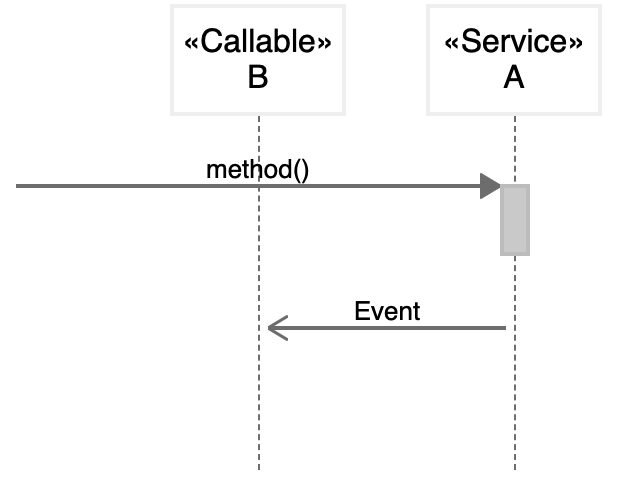A sequence diagram is an interaction diagram that shows how processes operate with one another and in what order.
Most developers would find the syntax fairly familiar. The following example demonstrates two basic syntax.
| Code Block |
|---|
A.method() A->B: Event |
| Zenuml sequence macro | ||||
|---|---|---|---|---|
| ||||
Participants
The participants can be defined implicitly as in the first example on this page. The participants are rendered in order of appearance in the diagram source text. Sometimes you might want to show the participants in a different order than how they appear in the first message. It is possible to specify the participant’s order of appearance by doing the following:
| Code Block |
|---|
B A A.method() A->B: Event |
| Zenuml sequence macro | ||||
|---|---|---|---|---|
| ||||
Stereotype
| Status | ||||
|---|---|---|---|---|
|
It is possible to add stereotypes to participants using << and >>.
| Code Block |
|---|
<<Callable>> B
<<Service>> A
A.method()
A->B: Event |
Messages
A message is shown as a line from the sender MessageEnd to the receiver MessageEnd.
| Info |
|---|
See Unified Modeling Language v2.5.1, section 17.4.4.1. |
Message type | DSL | Line and arrowhead (Spec) | ||||||
|---|---|---|---|---|---|---|---|---|
Asynchronous | A->B: Asynchronous message | solid line with open arrowhead | ||||||
Synchronous | A.method() | filled arrowhead | ||||||
Reply | reply = A.method(), or | dashed line with either an open or filled arrowhead | ||||||
Object creation | new ClassName() | dashed line with an open arrowhead | ||||||
Object deletion |
| Must end in a DestructionOccurrenceSpecification | ||||||
Lost |
| A small black circle at the arrow end of the message | ||||||
Found |
| A small black cirle at the starting end of the message |
Loops
The loop operand will be repeated a number of times. This is expressed by the notation:
| Code Block |
|---|
while(condition) {}
for(enumerator) {}
forEach(enumerator) {} |
See the example below:
| Code Block |
|---|
loop("Every minute") {
Alice->Bob: Great!
} |
| Zenuml sequence macro | ||||
|---|---|---|---|---|
| ||||
Alt
The alt operand represents a choice of behavior. At most one of the operands will be chosen. This is expressed by the notions:
| Code Block |
|---|
if (condition1) {
...
} else if (condition2) {
...
} else {
...
} |
| Code Block |
|---|
if (x) {
A.m1()
} else if (y) {
A.m2()
} else {
A.m3()
} |
| Zenuml sequence macro | ||||
|---|---|---|---|---|
| ||||
if (x) {
A.m1()
} else if (y) {
A.m2()
} else {
A.m3()
} |
